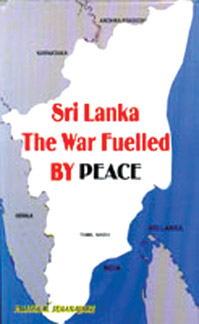War fuelled by peace
 A number of books has been written on the three-decade terrorism and
dawn of peace. Perhaps the subject has entered various social science
disciplines to the extent that many compilations have become sources for
further study. A number of books has been written on the three-decade terrorism and
dawn of peace. Perhaps the subject has entered various social science
disciplines to the extent that many compilations have become sources for
further study.
One scholar who has delved deeply into this subject area is Palitha
Senanayake, who writes a weekly column which pinpoints his keen interest
interlinked in politics, culture and communication.
The compilation, titled as Sri Lanka, the war Fuelled by Peace (2010)
sponsored by Professor F R Jayasuriya Foundation, is ample testimony to
prove his immense interest on the subject.
 In 21 chapters Senanayake makes the reader enter a journey of
unearthing the material from known to unknown throwing light on
obtaining legitimate responses to questions of how, what, when and where
pertaining to the subject. He obtains materials from basic news
bulletins, unpublished and published documents, letters, diaries,
profiles of people visit to places and other relevant sources. In 21 chapters Senanayake makes the reader enter a journey of
unearthing the material from known to unknown throwing light on
obtaining legitimate responses to questions of how, what, when and where
pertaining to the subject. He obtains materials from basic news
bulletins, unpublished and published documents, letters, diaries,
profiles of people visit to places and other relevant sources.
All in all it is a study of pre-colonial and post-colonial historical
scenes and events drawn from social commonplace happenings to upheavals.
In the first instance he makes his compilation look more scholarly by
laying down the basic demographic and geographic factors pertaining to
Sri Lanka.
What is avoided, as far as a reader feels, is his parochial outlook
of political biases for he always supports and collaborates evidence
from sources of reliability.
Some chapters look more like narratives written to kindle more
interest resulting in the provoking more thought and imagination.
Palitha also attempts to present the etymological and conceptual
meanings attached to some common usages one example is the term
‘diaspora’ widely used vaguely by masses.
Palitha lays down its origins in chapter 16 as follows:
The word ‘diaspora’ is of Greek origin and was initially used to
describe the displacement of Jews from the lands of Mesopotamia. The
Jews thus scattered in different parts of the world eventually became a
force to reckon within the countries where they settled themselves and
their impact on local populations warranted them the term ‘diaspora’ to
be coined to describe this collective impact. (418pp)
But according to Palitha, the term as used in Sri Lanka, Tamil
diaspora perhaps is a misnomer. The local contextual meaning given to
Tamils in Sri Lanka does not comprise a ‘displaced section’ or a
displaced community.
Palitha categorically refers to them as ‘a group who have migrated to
countries for better economic conditions, often against the will of Sri
Lankan government that had educated them at the taxpayer’s expense’
(418pp).
He too attempts to trace the origins and gradual spreads of the
ethnic pressure groups in Sri Lanka with special reference to the LTTE.
Perhaps with the lapse of time and the growth of interdisciplined
appearances of social studies, the compilation ought to fill a vacuum
unwritten by historians. He too tries to link terms such as ‘asylum
seeker’ and ‘ethnic issues’ in the context of application of the terms
in a historic perspective (418pp).
One interesting detail connected with the use of mass media appears
in chapter is titled as ‘Propaganda English media and dubious media
agenda’ (384-417pp).
In this chapter the compiler, critic and interpreter Senanayake tries
in a critical vein to present basic concepts of propaganda and
visualizes the extent to which it had obliterated the impartial views of
the common masses via hidden agenda at home and abroad. He does not
present mere statements but tries his best of informative knowledge to
compare material gone into mass media channels.
He collects views from various angles and tries to arrive at certain
interpretations.
He has also taken an interest in presenting views and opinions found
in books such as Jean Arasanayagam’s Fire Sermon and the Sack. He too
lays emphasis on mass media ownership and the dominant social and
political views held by respective owners.
The conceptual meaning in ‘propaganda’ is shown from several points
of view enabling the reader to rethink critically about his stance. The
book does not hold a beginning, middle and a conclusion as is found in
many works of this calibre. It is a vast collection of socio political
and socio cultural material interpreted to create a better awareness of
the Sri Lankan situation.
Having laid down background facts of the three-decade anti terrorism
battle in Sri Lanka, the writer states that Sri Lanka could start by
introducing anti terrorist equipment with all its experience gained by
overcoming the most successful terror outfit in the world.
This book needs an index, which presumably would help the researcher.
|



